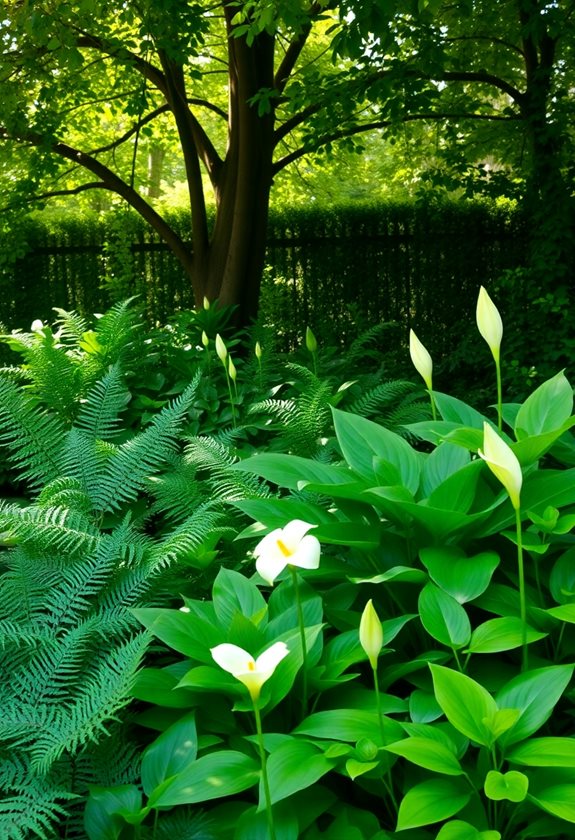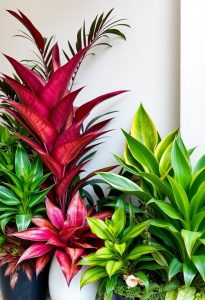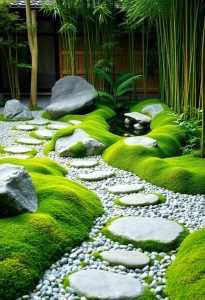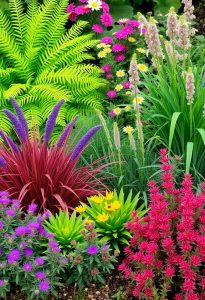If you’ve got a shady spot, don’t fret! Some amazing foliage plants thrive in low light. Think about Snake Plants – they’re super stylish and practically indestructible! ZZ Plants have glossy leaves that’ll brighten up any corner. Pothos adds a fun trailing vibe, while Cast Iron Plants are your go-to for easy care. Ferns and Hostas are fantastic for outdoor gardens too! Want to know how to keep them happy and thriving? There’s plenty more to learn!
Design Highlights
- Snake Plants and ZZ Plants thrive in low-light conditions, making them ideal for indoor shaded areas.
- Pothos features trailing vines that add elegance while flourishing in minimal light.
- Outdoor Hostas and Ferns are resilient options that enhance shaded gardens with lush beauty.
- Astilbes and Bleeding Hearts provide vibrant blooms, adding color to low-light outdoor spaces.
- Shade-loving plants often have larger leaves to effectively capture filtered light for growth.
Understanding Low-Light Conditions
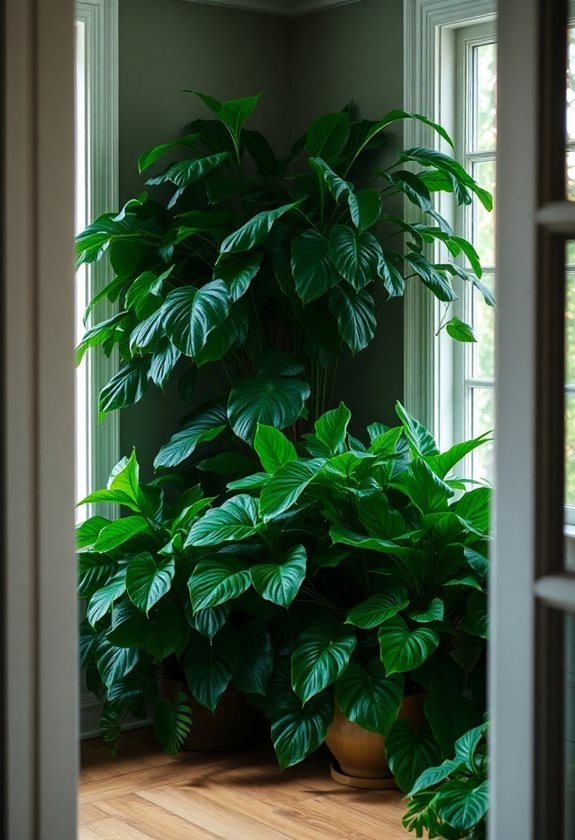
When you step into a shady corner of your garden, it might feel like the plants are playing hide-and-seek with sunlight, right? Understanding low-light conditions is essential for nurturing healthy foliage. You may wonder, how much light do these plants really need? Generally, low-light means indirect sunlight or just a few hours of filtered light daily.
Consider these tips:
- Assess light levels using a simple hand test.
- Choose plants like ferns or snake plants that thrive in these conditions.
- Rotate plants occasionally for even exposure.
Additionally, many perfect foliage plants are specifically suited for shaded areas, ensuring your garden remains lush and vibrant. With patience and knowledge, you can transform that shady nook into a vibrant oasis!
Top Foliage Plants for Indoor Shade
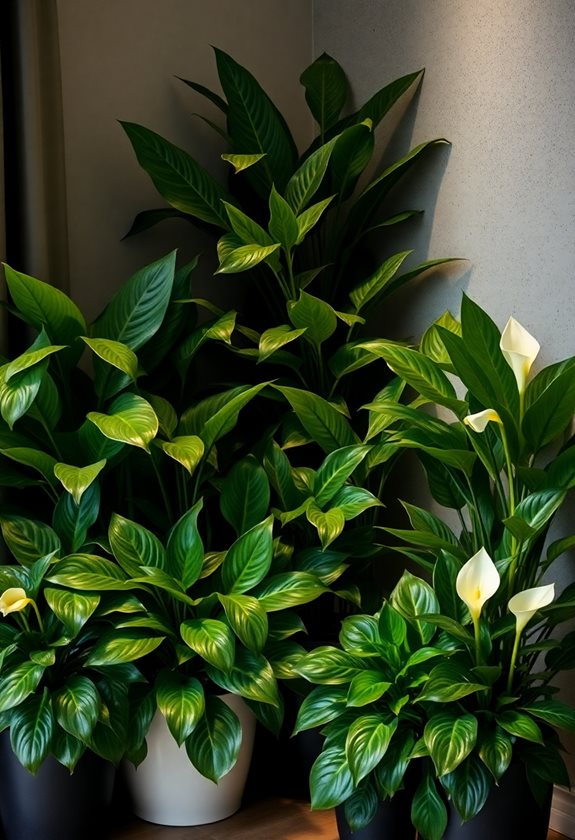
If you’re looking to brighten up your indoor spaces without much sunlight, you’re in luck! Some fantastic foliage plants thrive in shade. Consider the resilient Snake Plant—its upright leaves are sure to catch your eye. The ZZ Plant, with its glossy, dark green leaves, brings a sleek vibe that’s hard to resist. And don’t forget about Pothos; its trailing vines can elegantly drape from shelves! Want to add a pop of color? Try the Cast Iron Plant! These beauties not only survive but thrive in low-light conditions. Additionally, many of these plants are also drought-resistant, making them perfect for effortless gardening. Ready to transform your space? Let’s explore these leafy wonders together!
Best Outdoor Plants for Shaded Gardens
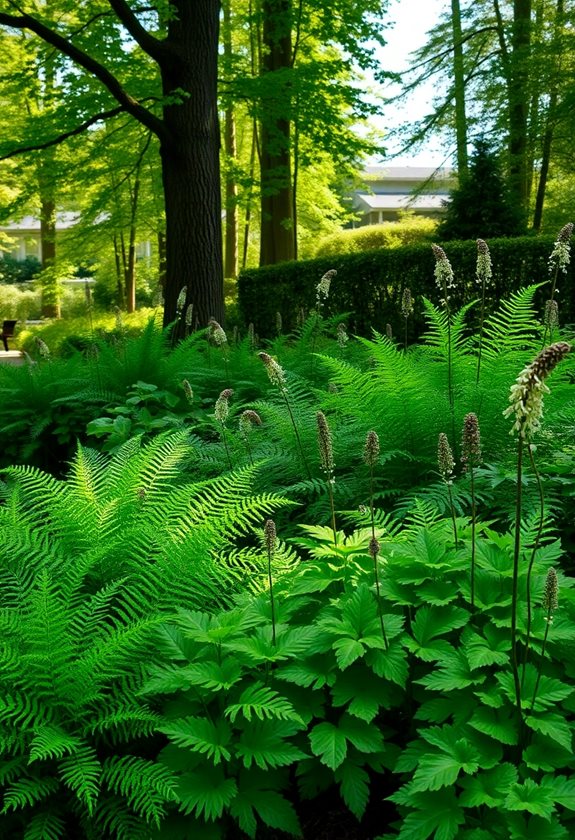
Creating a stunning outdoor garden in shaded areas can feel like a challenge, but it’s totally achievable with the right plants! You might want to contemplate hostas, ferns, or astilbes. They thrive in low-light conditions and add lush beauty. Don’t forget about bleeding hearts and lungwort, which bring a splash of color!
Pro Tip: Combine different textures and heights for visual interest. Additionally, consider incorporating shade-loving plants that can enhance the diversity of your garden.
Have you thought about using containers? They can brighten up shady spots too! Remember, a little creativity goes a long way. So, roll up your sleeves and transform your shaded garden into a vibrant oasis!
Unique Characteristics of Shade-Loving Plants
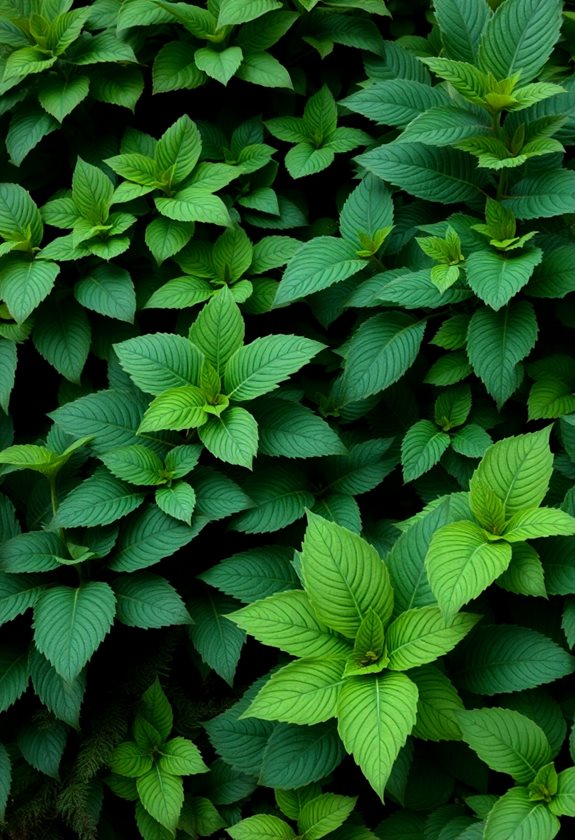
Shade-loving plants are fascinating not just for their ability to thrive in low-light conditions, but also for their unique characteristics that can truly transform a garden. Have you ever noticed their vibrant colors and intriguing textures? Many of these plants, like hostas and ferns, boast lush foliage that adds depth and interest. Plus, they often have larger leaves to capture what little light filters through. They can also tolerate varying moisture levels, making them resilient. These traits not only create a stunning visual appeal but also provide a perfect canvas for your gardening creativity. Isn’t it exciting to explore? Additionally, many shade-tolerant plants exhibit dense foliage adaptations that enhance their survival in low-light environments.
Tips for Caring for Shade Foliage
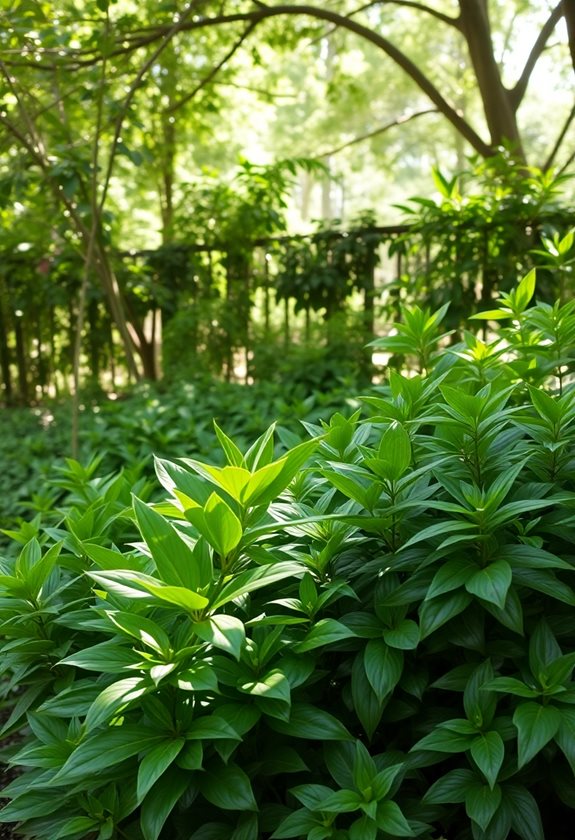
While it might seem intimidating to care for foliage plants in shaded areas, you’ll quickly discover that these green beauties have their own set of needs that, once understood, can make your gardening journey a delightful experience. Start by choosing the right soil—loamy and well-draining is ideal. Water them regularly, but don’t drown them! Check for pests like aphids, and keep an eye on their leaves for any signs of distress. Consider using organic fertilizers to nourish them. Have you tried talking to your plants? They love the attention! Additionally, incorporating layering techniques can significantly enhance the visual depth of your shade garden. With a little patience, you’ll have a thriving shade garden in no time!
Designing Your Space With Shaded Plants
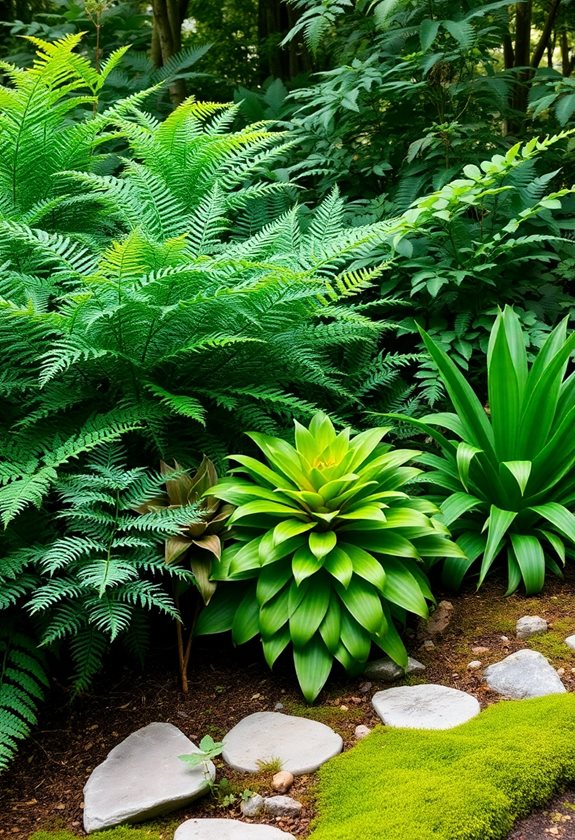
When you think about designing your garden, don’t overlook the beauty and potential that shaded areas offer! With the right plants, you can create a lush, inviting space. Here are some tips to get you started:
Don’t underestimate the charm of shaded areas; with thoughtful plant choices, you can craft a vibrant, welcoming garden retreat.
- Layer your plants for visual interest—tall ferns in the back, shorter hostas in front.
- Choose a color palette that complements your home and garden style.
- Incorporate texture with varying leaf shapes and sizes for depth.
- Add lighting to showcase your shaded oasis at night.
Additionally, consider using shade-loving plants that are specifically suited for low-light conditions to enhance your garden’s beauty. Embrace your creativity, and don’t be afraid to experiment! Your shaded garden could become the highlight of your yard.
Common Mistakes to Avoid in Low-Light Gardening
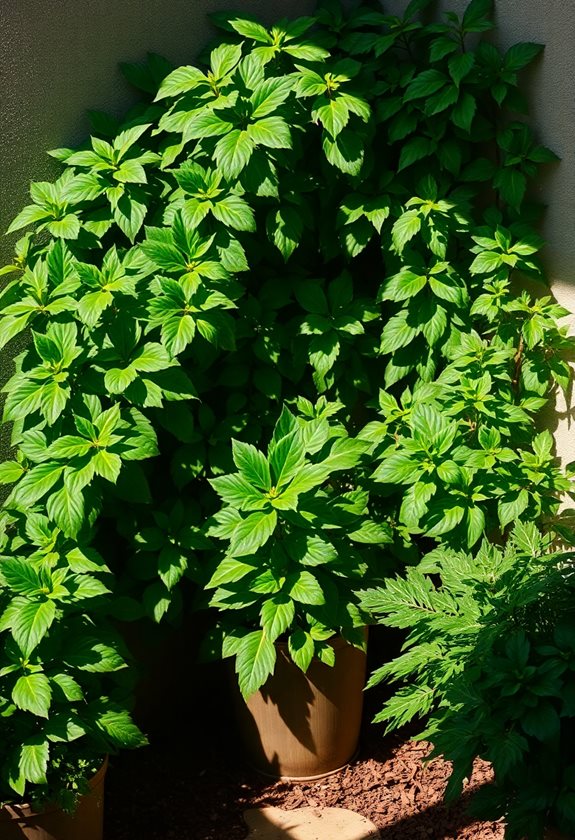
If you think low-light gardening is a piece of cake, you might be in for a surprise! Many gardeners underestimate the challenges. Here are some common mistakes to avoid:
- Overwatering: Low light means slower growth, so water less often.
- Wrong plant choices: Not all plants thrive in shade. Research is key!
- Ignoring humidity: Many shade-loving plants enjoy moisture, so misting helps.
- Choosing high-maintenance plants: Selecting low-maintenance plants can simplify your gardening experience in shaded areas.
Frequently Asked Questions
Can I Grow Vegetables in Shaded Areas?
Sure, you can grow vegetables in shaded areas, but you’ll need to choose wisely! Not every plant loves the shade. Try leafy greens like spinach and lettuce, or even root veggies like radishes and carrots. They thrive in partial sun. Remember, don’t forget about soil quality and moisture! Have you thought about using containers? They can add a pop of color and make your shady spots more vibrant. Happy gardening!
How Do I Know if My Plant Is Getting Enough Light?
Imagine your plant yearning for sunlight like a child chasing after a rainbow! To know if it’s getting enough light, check for vibrant leaves and sturdy growth. If they’re yellowing or stretching towards the light, it’s time to adjust. Consider these tips:
- Place it near a window.
- Rotate it weekly for even light.
- Observe its growth patterns.
Trust your instincts—your plants will tell you what they need! Happy gardening! 🌱
What Soil Types Are Best for Shade Plants?
When picking soil for shade plants, you’ll want something that retains moisture but drains well. A mix of loamy soil with organic matter, like compost, is ideal. Here’s why:
- Moisture Retention: Keeps your plants happy!
- Nutrient-Rich: Helps them thrive.
Consider adding perlite for aeration, too. Have you ever seen a plant struggle in heavy clay? It’s heartbreaking! So, let’s keep your shaded garden lush and vibrant!
Are There Any Pests That Prefer Shaded Plants?
Did you know that over 30% of garden pests prefer shady spots? It’s true! These critters, like slugs and aphids, love moisture and coolness. To protect your plants, consider these steps:
- Regularly check for pests.
- Use natural deterrents like diatomaceous earth.
- Keep your garden tidy; debris can hide pests!
How Often Should I Fertilize Shade-Loving Plants?
Fertilizing shade-loving plants can be tricky, but it’s essential for their growth! Generally, you should fertilize them every 4 to 6 weeks during the growing season, which is usually spring to early summer. A balanced, slow-release fertilizer works wonders! Have you ever noticed how some plants just perk up after a little boost? Just remember, too much fertilizer can be harmful, so always follow the package instructions! Happy gardening!

